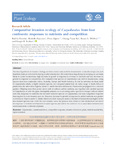Mostrar o rexistro simple do ítem
Comparative Invasion Ecology of Carpobrotus From Four Continents: Responses to Nutrients and Competition
| dc.contributor.author | Portela Carballeira, Rubén | |
| dc.contributor.author | Barreiro, Rodolfo | |
| dc.contributor.author | Alpert, Peter | |
| dc.contributor.author | Xu, Cheng-Yuan | |
| dc.contributor.author | Webber, Bruce | |
| dc.contributor.author | Roiloa, Sergio | |
| dc.date.accessioned | 2023-05-25T17:57:07Z | |
| dc.date.available | 2023-05-25T17:57:07Z | |
| dc.date.issued | 2023-01-24 | |
| dc.identifier.citation | Rubén Portela and others, Comparative invasion ecology of Carpobrotus from four continents: responses to nutrients and competition, Journal of Plant Ecology, Volume 16, Issue 1, February 2023, rtac034, https://doi.org/10.1093/jpe/rtac034 | es_ES |
| dc.identifier.issn | 1752-993X | |
| dc.identifier.uri | http://hdl.handle.net/2183/33138 | |
| dc.description.abstract | [Abstract] Two key hypotheses in invasion biology are that certain traits underlie invasiveness in introduced species, and that these traits are selected for during or after introduction. We tested these hypotheses by focusing on two traits likely to confer invasiveness, high increase in growth in response to increase in nutrients and low decrease in growth in response to competition. We compared four species of Carpobrotus that differ in invasiveness, using species from four continents: Africa, Australia, Europe and North America. To test for selection for these traits in Carpobrotus edulis, a highly invasive species, we compared plants from its native range in South Africa to plants from the other three regions, where C. edulis has been introduced. Plants were propagated in a common garden. Offspring were then grown alone with or without added nutrients, and together with another species of Carpobrotus or with the grass Ammophila arenaria (a co-occurring native species in Europe) without added nutrients. Response to nutrients did not differ between species of Carpobrotus, nor was competitive response less negative in more invasive species. However, increase in growth in response to added nutrients was greater in introduced than in native C. edulis. Moreover, fresh mass per ramet at the start of treatments was higher in the two invasive species than in the two non-invasive ones. We provide new evidence that introduction can select for response to nutrient enrichment in invasive species and add to the evidence for an association between size and invasiveness in introduced plants. | es_ES |
| dc.description.abstract | [摘要] 四大洲食用昼花属的比较入侵生态学:对养分和竞争的响应 入侵生物学的两个关键假设是,某些特征是外来物种入侵的基础,且这些特征是在引入期间或之后选择的。我们通过关注两个可能赋予入侵性的特征来检验这些假设,即营养增加引起的较高生长加速和竞争引起的较低生长减速。我们对采自非洲、澳洲、欧洲和北美洲的4个食用昼花属(Carpobrotus)品 种进行了比较。为了测试高入侵物种莫邪菊(Carpobrotus edulis)对这些特征的选择,我们将原产于南非 的植株与入侵其他3个地区的植株进行了比较。在一个同质园中繁殖植株。然后,在添加或不添加养分的情况下单独培育子代,并在不添加养分的情况下将子代与另一个食用昼花属品种一起、或与欧洲的一种共生本土物种马兰草(Ammophila arenaria)一起培育。不同品种的食用昼花属对营养物质的反应并无差异,在入侵性更强的物种中,竞争反应的负面性也没有减弱。然而,与本土莫邪菊相比,添加营养物质引起外来莫邪菊更高的生长加速。此外,在处理开始时,两种入侵物种每分株的鲜质量高于两种非入侵物种。我们的研究结果表明,引种可以选择入侵物种对营养富集的反应进行选择,也证明了外来植物的体积和入侵性之间的关联。 | es_ES |
| dc.description.sponsorship | Australian samples were collected under licenses SW018396 and CE005442 issued by the Western Australian Department of Parks and Wildlife. This paper is a contribution from the Alien Species Network (Ref. ED431D 2017/20—Xunta de Galicia, Autonomous Government of Galicia). Spanish Ministry of Economy and Competitiveness (Grant CGL2013-44519-R, co-financed by the European Regional Development Fund, to S.R.R.) and CSIRO Julius Career Award (to B.L.W.) | es_ES |
| dc.description.sponsorship | Xunta de Galicia; ED431D 2017/20 | es_ES |
| dc.language.iso | eng | es_ES |
| dc.publisher | Oxford Academic | es_ES |
| dc.relation | info:eu-repo/grantAgreement/MINECO/Plan Estatal de Investigación Científica y Técnica y de Innovación 2013-2016/CGL2013-44519-R/ES/¿QUE PROVOCA QUE UNA PLANTA SE CONVIERTA EN UN INVASOR AGRESIVO? ADAPTACION Y EVOLUCION DE LOS ATRIBUTOS CLONALES DURANTE PROCESOS DE INVASION/ | es_ES |
| dc.relation.uri | https://doi.org/10.1093/jpe/rtac034 | es_ES |
| dc.rights | Atribución 4.0 Internacional | es_ES |
| dc.rights.uri | http://creativecommons.org/licenses/by/4.0/ | * |
| dc.subject | Carpobrotus | es_ES |
| dc.subject | Coastal sand dune | es_ES |
| dc.subject | Competitive response | es_ES |
| dc.subject | Invasive introduced plant | es_ES |
| dc.subject | Nutrient availability | es_ES |
| dc.subject | Rapid evolution | es_ES |
| dc.subject | 食用昼花属 | es_ES |
| dc.subject | 海岸沙丘 | es_ES |
| dc.subject | 竞争反应 | es_ES |
| dc.subject | 外来入侵植物 | es_ES |
| dc.subject | 养分有效性 | es_ES |
| dc.subject | 快速进化 | es_ES |
| dc.title | Comparative Invasion Ecology of Carpobrotus From Four Continents: Responses to Nutrients and Competition | es_ES |
| dc.type | info:eu-repo/semantics/article | es_ES |
| dc.rights.access | info:eu-repo/semantics/openAccess | es_ES |
| UDC.journalTitle | Journal of Plant Ecology | es_ES |
| UDC.volume | 16 | es_ES |
| UDC.issue | 1 (February 2023) | es_ES |
| UDC.startPage | rtac034 | es_ES |
| dc.identifier.doi | 10.1093/jpe/rtac034 |






